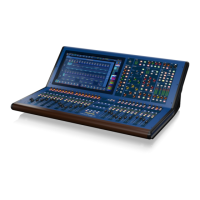151 HD96-24-CC-TP User Manual
Item Control Function
1 Tap - Button Tap tempo button. Requires a minimum of 3 taps to attain an accurate tempo.
2 Global - Button Follows the global tap tempo when active and allows the surface tap button to be used
3 Mode - Button Switches between BPM and ms in the display.
4 Delay Time - Display Shows the current delay time in either BPM or ms depending on settings
5 BPM/ms - Display Shows current tempo display mode.
6 Down Arrow - Button Moves the tempo down by either 1 ms or 0.1 BPM depending on mode.
7 Up Arrow - Button Moves the tempo up by either 1 ms or 0.1 BPM depending on mode.
8 X2 - Button Doubles the current ms or divides by 2 if in BPM mode.
9 Tempo - Control
Adjust the tempo with a pop up rotary control (can be locked to screen). 1ms - 2 s or 1 BPM - 2000
BPM. X2 Double the maximum possible time.
10 Low Freq Cut - Control Swipe the graph to change the low frequency cuto point. 10 Hz - 500 Hz
11 High Freq Cute - Control Swipe the graph to change the high frequency cuto point. 200 Hz - 20 kHz
12 Low Freq Cut - Rotary Control Press number for rotary control of low frequency cuto point.
13 High Freq Cut - Rotary Control Press number for rotary control of high frequency cuto point.
14 Low Freq Cut Post FB - Button Places the low cut lter after the feedback tail.
15 High Freq Cut Post FB - Button Places the high cut lter after the feedback tail.
16 Bypass - Button Bypass the delay, signal still runs through the eect.
17 Mix - Control Adjusts the wet/dry balance. Turn fully right for a completely wet signal.
18 Feedback - Control
Adjusts the amount of negative/positive feedback applied to delay. Controls the number of repeats.
Range is from 0% to 100%.
19 Input - Meter 29 LEDs which show stereo input metering.
20 Output - Meter 29 LEDs which show stereo output metering.
TC 2290 Delay
The TC 2290 is a classic studio and live sound delay unit which is widely viewed as one of the best delay eects ever made.
Insert vs Aux Eect
The TC2290 can be inserted directly into an eect slot on a single channel, which passes the entire signal through the eect. In this case, note that the direct input
signal becomes mono before it is panned, either statically or modulated. This occurs when the PAN/DYN section DIRECT button is engaged.
However, the TC2290 can also be added to an aux bus and one or more channels can send a portion of their signal to this bus to be processed by the eect. The output
of the eect is then mixed back in with the rest of the tracks. This diers from an insert eect in that the TC2290 isn't aecting the track's entire signal, so the direct
signal cannot be modulated using the MOD buttons in the PAN/DYN section. In this setup, the Mix parameter should always be set to 100%.
Mono/Stereo Operation
The TC2290 can be used both as a mono instance on mono channels and a stereo instance on stereo channels.
In the case of a mono out instance, the output signal is made by outputting the left plug-in channel only. In this case, panning should not be used.
Meters
The meter section gives feedback about the incoming and outgoing audio signals. The input level displays the audio as it enters the plug-in and is not aected by
adjustments to the input level control or any other parameter. The output meter is aected by the results of the eect as well as the output level control parameter.
Glob. Tap
The TC 2290 can follow the global tap tempo set from the console. When engaged the Delay Time control adjusts the divide parameter from: 1/16T, 1/16, 1/16 dotted,
1/8T, 1/8, 1/8 dotted, ¼T, ¼, ¼ dotted, ½T, ½, ½ dotted, 1T, 1, and 1 dotted. This is a great way to create “Dub” eects when using T or dotted timings.

